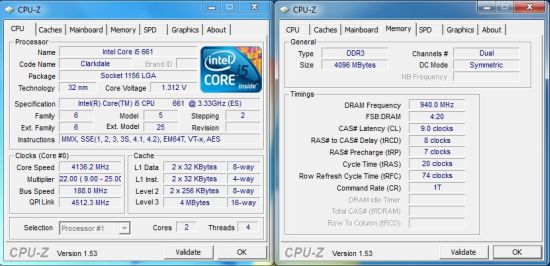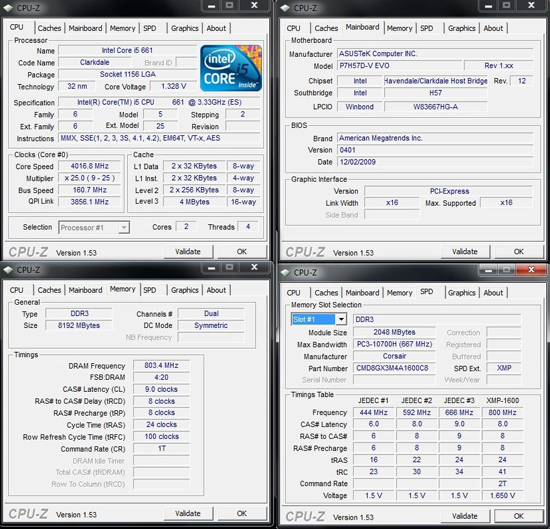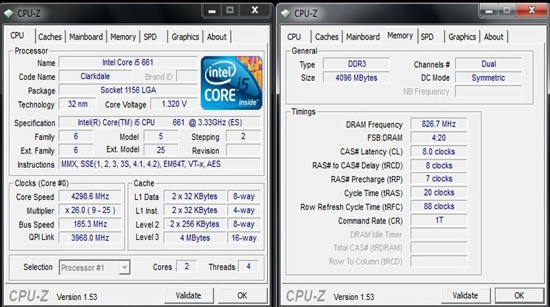Choosing the Best H55/H57 Motherboard - Part 1
by Rajinder Gill on January 31, 2010 11:30 PM EST- Posted in
- Motherboards
Overclocking - Dissent in the Ranks
Ok, let's start off with a discrete GPU. When using 4GB configurations, the best board of the bunch appears to be the ASRock.

It's the only board that manages this speed fully stable with our Corsair Dominator kit. This is surprising considering the ASRock board has the least overclocking centric BIOS of the boards we have on test today. Voltage scales are fairly coarse in stepping, and memory sub-timing options are limited together with control over the QPI multiplier, but this does not seem to affect the board when it comes to 4GB memory configurations using the 2:10 memory ratio, even when using "lesser" performance modules.
The H57 EVO manages to take the same components to around 182 BCLK while the MSI and ASUS H55 models reach their limits at around 175 BCLK - around 130MHz lower than the ASRock board for raw memory frequency.
8GB memory overclocking is a different story. The leader in this department is the most expensive board on test today, the ASUS H57M EVO:

ASUS' H57 offering pips the ASUS H55M EVO to the post with our 8GB Corsair memory kit. The H55 model manages around 1580MHz fully stable vs. 1600MHz stable on the H57.
The ASRock's limits come in around 1450~1500MHz because you don't get access to some of the sub-timings needed to run higher memory speeds fully stable when the DIMM slots are loaded with 8GB, nor do you get the option to lower the QPI multiplier. That lands you at frequencies that the IMC cannot handle when loaded heavily.
MSI's BIOS provides plenty of additional sub-timing options, although we could not find a combination of settings to help achieve what we managed on both of the ASUS boards using the same memory modules. The QPI ratio had to be dropped to accommodate, while memory sub-timings needed loosening to achieve full stability.
One thing worthy of mention here, S3 sleep resume will work on the ASUS H55/H57 EVO boards and the MSI board at 200BCLK and beyond if you use lower memory multiplier ratios and QPI multipliers. The ASRock H55M-Pro is limited to a maximum of 190 BCLK for sucessful S3 resume on current BIOS releases.
Overclocking with the IGP Active
This is where things become limited rather quickly when it comes to maximum stable BCLK frequency. Anything over 165 BCLK needs judicious amounts of IGP voltage to facilitate higher CPU core speeds, even if you don't overclock the IGP in tandem. Using our 661 sample CPU and retaining the stock 900MHz IGP frequency, a BCLK of 165 is possible on all four boards using the 2:10 memory ratio and the highest available QPI multiplier. Anything higher and we have to pump an extra 0.1V into the IGP to get to 175 BCLK.

One would think that using a lower the QPI multiplier and memory ratio would increase headroom somewhat, but it appears this is not the case. We tried all QPI multipliers in conjunction with the 2:8 and 2:6 memory ratios and could not find a combination that was stable enough to enter the OS over 175 BCLK. Whether or not this is down to vendors getting to grips with the platform or not is currently unknown to us, although it would not be surprising if that happens to be the case. Time will tell.
We've run out of time to explore every angle of IGP performance and QPI ratios in this article, but we will endeavor to cover this angle in a future article if need be. Right now, we'll say it appears that you're going to be BCLK limited south of 170 MHz with the IGP in tow. Subtract another 20MHz off that for 8GB configurations, and bear in mind that you'll need to use low memory speeds, capping you to a maximum of around DDR3-1333MHz with things in their current state.










56 Comments
View All Comments
Rajinder Gill - Monday, February 1, 2010 - link
Hi,For i3 530 results, you can compare the i3~i5 deltas in Anand's coverage here;
http://www.anandtech.com/cpuchipsets/showdoc.aspx?...">http://www.anandtech.com/cpuchipsets/showdoc.aspx?...
That gives as a basic idea of what to expect. The actaul IGP consumption variance from board to board will be aroud 10~15w I'd expect. I can run some fo this stuff in the follow up.
regards
Raja
hyvonen - Monday, February 1, 2010 - link
Hi Raja,The MSI H55M-ED55 looks awesome for low-power HTPC, but the lack of undervolting is an incomprehensible miss on MSI's part. If they are as gung-ho about low-power as they claim, they should most definitely offer undervolting too.
Could you guys suggest to MSI that they should add undervolting options to their future BIOS releases? I know Anand's team has a lot of influence on manufacturers, and this could really help out MSI and their customers alike.
Rajinder Gill - Monday, February 1, 2010 - link
Sure thing, I'll pop it in a message to them.regards
Raja
hyvonen - Tuesday, February 2, 2010 - link
Thanks - this is much appreciated.YellowWing - Monday, February 1, 2010 - link
Thanks for the link to Anand article, but all of his power figures are for a machine using a graphics adapter. The i5-661 and i3-530 clock the graphics at different rates. So... imho it would be ideal to see idle and load figures for the i3-530.hyvonen - Monday, February 1, 2010 - link
SilenPCReview has a pretty good review on i5-661, where the system is configured for HTPC purposes (i.e., IGP & superlow power). They even touch on PSU efficiency at low power levels (the efficiency is pretty awful, even for a 450W 80plus PUS).http://www.silentpcreview.com/intel-clarkdale">http://www.silentpcreview.com/intel-clarkdale
I've already decided to go with a PicoPSU that should give me about 80% efficiency at 20-30W idle.
hyvonen - Monday, February 1, 2010 - link
Oh, and I wanted to point out that i5-661 was idling at extremely low power levels in that review. Moreover, I've seen another review somewhere comparing i5-661s and actual i3-530s - in that review, the i3-530 idle power was higher! My guess is that the idle power levels are so low in both that it's all within measurement noise.nuudles - Monday, February 1, 2010 - link
Hi Anand,Any news on when we will start seeing mini-ITX H55/57 boards? With more and more mATX boards mini-ITX is becoming the mATX of a couple of years ago.
I know that there is one DFI mini-ITX p55 board at Newegg, but it is $147 with shipping, plus something like a i3 530 would be an ideal match for a mini-ITX H55 for a very small + low power system (HTPC, etc).
Or if you add a small-ish video card like a 5750 then you have a nice and small (non-hardcore) gaming system.
Thanks!
Rajinder Gill - Monday, February 1, 2010 - link
Hi,We expect some of these vendors to have M-ITX boards somewhere over the next few months (hopefully).
Zotac have a H55 model that should be on sale soon:
http://pden.zotac.com/index.php?page=shop.product_...">http://pden.zotac.com/index.php?page=sh...mp;optio...
Nothing concrete yet from the big players in terms of release dates/models etc unfortunately.
regards
Raja
AstroGuardian - Monday, February 1, 2010 - link
Hello Raja and everyone:Would you be so kind and point me to a site or anything that has Intel and AMD chips compared? Live Lynnfield vs Clarkdale vs everything?
I have been into hardware for a loooong time but i was doing some science work lately and i am out of grip with latest chips.
Thanks everybody. This review was great